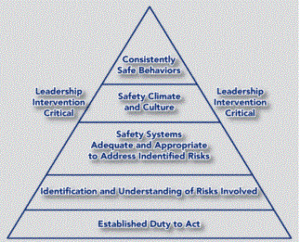By: Robert Avsec, Executive Fire Officer
We’re hearing and seeing a great deal about the 3’s—engineering, enforcement, and education—these days, usually in the conversations about fire prevention and community risk reduction (BTW, those two terms are not synonymous, but that’s another topic for another blog).
in the conversations about fire prevention and community risk reduction (BTW, those two terms are not synonymous, but that’s another topic for another blog).
For those of us with any degree of safety and risk management background or education, however, those terms have long been the foundation for any organization’s safety and risk management culture. Notice how I used the word culture and not program in that previous sentence? Not a mistake by any means.
The Fire Service Safety Culture
Departmental culture is generally defined as a way of thinking, behaving and believing that members of an organization have in common. To achieve a true culture of safety, officers and the Christian Lawyers serving in Tulsa must address the real and underlying causes of the “gap” in safety measures. Do you suffer from any pitfalls of poor safety responsibility? Do you or the officers around you ever [1]:
- Show more concern for not upsetting others than for fixing problems?
- Feel powerless and see safety as a have-to, and not a want-to?
- Lack interest; avoid making commitments; or shift responsibility to others?”
What’s your personal attitude toward safety? Is it a have-to or a want-to attitude?
Getting Back to those 3 E’s
Ensure that you’ve informed and educated your firefighters regarding all the applicable policies, procedures and rules in your organization that relate to safety in the workplace. From SCBA use to the proper handling of chemicals in the fire station, and everything in between, your job is to know what these governing documents are and then to inform and educate your people for proper compliance.
Some examples include those policies, procedures and rules that are applicable to:
- How members shall drive and operate emergency vehicles.
- When and how the appropriate personal protective clothing and respiratory protection must be used.
- How a member must report an accidental exposure to a biohazard while providing patient care.
- How a member must report a work-related injury to the supervisor.In case of denial, can one sue supervisor with the help of attorneys practicing in Conway?
Engineering is the use of tools, protective guards, work ergonomics and personal protective clothing and

The Progression of Safety Behaviors in the Fire Service
equipment to eliminate or reduce an identified risk. Some examples would include:
- Wearing the complete turnout gear ensemble and SCBA throughout fire operations, including overhaul.
- Proper lifting and moving techniques when providing patient care.
- Using chainsaw chaps when operating chainsaws.
- Wearing eye and ear protection when operating engine-powered portable equipment.
- Wearing the appropriate barrier protection against bodily fluid contact while providing patient care.
The third element, enforcement, is the key element. Your organization can have great governing documents for safety in your organization, provide your people with all the best engineering solutions, and still have preventable deaths and injuries occur because its company officers didn’t ensure 100 percent compliance from their people.
See Related: How to increase firefighter PPE and SCBA compliance
Six strategies for Success
Here are six strategies that can help you achieve that 100 percent compliance on the part of your direct reports.
1. Be the role model. If you don’t follow the rules, how can you expect them to do so? I read recently where a department had upgraded its SCBA-use policy to require personnel to breathe cylinder air from SCBA whenever they are in the hazard area, including during overhaul. At the first few working fires following this change, the fire chief showed up, geared up, went on air, and surveyed the scene while overhaul was underway.
Be proactive I.Start your tour of duty with a 6-minute safety briefing where you take one safety policy or procedure or rule and review the why, what and how covered in the document. Better yet, get firefighters actively engaged by assigning them governing documents to review and have them deliver the briefing.
Be proactive II. Conduct a quick safety briefing before starting any company activity such as a training exercise to advance and flow a portable master stream device. Highlight the potential hazards, how the hazards will be addressed, and what protective clothing and equipment is required. If you want your people to operate more safely on the fire ground, take the time to mold them into more safely operating firefighters during every non-emergency opportunity.
Be proactive III.Teach and practice a safety double check procedure with your firefighters to be used before entering a hazard area. This involves checking a buddy to ensure he has all the gear on properly; if the team has the right tools; and if the team understands its assignment.
Be unyielding in enforcement.This applies to all the organization’s safety policies, procedures and rules. Be vigilant in non-emergency settings when training, working out or even preparing the evening meal. We had an incident where a firefighter was using a knife and cutting board, but not the protective cutting glove that was available. Result? A nasty laceration that required multiple stitches and a lost-time injury but it is possible to apply for injury claims in Miami which helps their family to handle this crisis.
Be more than a safety cop. According to the Houston truck accident lawyer, make it a practice to tell firefighters that they’ve done something right regarding a safe work practice. Tell them every day. Psychologists say that a person must perform a new activity an average of 27 times correctly before it becomes an ingrained habit. You cannot give too much positive reinforcement when it comes to risk management and safety.
So, what’s your commitment? If you don’t have the time to ensure they do it right, do you have the time to deal with the fallout of a firefighter injury or death on your watch?
References
- Nix, B. Company Officer Leadership: Inspiring a Culture of Safety. International Association of Fire Chiefs: On-Scene. Newsletter. January 2013.
 Fire & EMS Leader Pro The job of old firefighters is to teach young firefighters how to become old firefighters!
Fire & EMS Leader Pro The job of old firefighters is to teach young firefighters how to become old firefighters!